Brutalist architecture has a perfectly appropriate name.
The design conveys, well, brutality. The movement, which was most popular in the middle of the 20th century, was marked by its cold, sterile appearance. Extremely functional, very linear, and lots of concrete. A retrofuturistic attempt at modernism.
It’s a little funny, then, to see Brutalist buildings recreated with the same type of blocks that can be used to construct the Firehouse Headquarters from "Ghostbusters."
German artist Arndt Schlaudraff uses LEGO blocks to build notable Brutalist structures. He posts photos of his work on his Instagram account.
Not all Brutalist structures are plain, nor do they have beauty only in their subtlety. Some of the models Schlaudraff have made are really striking. Some entries are fictitious, and some are based off of existing buildings. Schlaudraff doesn’t sell his pieces; instead, he take photos and destroys the models so he can repurpose the bricks.
The artist spoke with Dezeen about his fascination with Brutalism and LEGOs.
Related Stories
Architects | Mar 30, 2015
Q+A with Arthur Gensler, and advice from his new book
"Designers need to be trained to solve their clients’ problems through design while leading their own firms to become sustainable practices," says Gensler.
Structural Materials | Mar 30, 2015
12 projects earn structural steel industry's top building award
Calatrava's soaring Innovation Science and Technology Building at Florida Polytechnic University is among the 12 projects honored by the American Institute of Steel Construction in the 2015 IDEAS² awards competition.
Cultural Facilities | Mar 30, 2015
Designs released for new entertainment center in Lubbock, Texas
Amenities of the facility include a performance venue that seats 2,220, a smaller one that seats 425, a 6,000-sf multipurpose room, and a bistro café.
Multifamily Housing | Mar 27, 2015
Bathroom fixtures get a starchitect makeover by Bjarke Ingels
This Danish starchitect elevates the toilet paper holder (and other bathroom accessories).
Architects | Mar 27, 2015
Illustrator Federico Babina explores architecture as animals
When you pay attention, the Eiffel Tower really does look like a giraffe.
Transit Facilities | Mar 25, 2015
Kengo Kuma selected to design new Paris Metro station
The new station will serve as a hub to connect Paris' northern suburbs with the core.
Green | Mar 25, 2015
WELL Building Standard introduced in China
The WELL Building Standard is a performance-based system for measuring, certifying and monitoring features that impact human health and wellbeing, through air, water, nourishment, light, fitness, comfort, and mind.
High-rise Construction | Mar 24, 2015
Timber high-rise residential complex will tower over Stockholm waterfront
The four towers, 20 stories each, will be made entirely out of Swedish pine, from frame to façade.
Higher Education | Mar 23, 2015
Hong Kong university building will feature bioclimatic façade
The project's twin-tower design opens the campus up to the neighboring public green space, while maximizing the use of summer winds for natural ventilation.
Religious Facilities | Mar 23, 2015
Is nothing sacred? Seattle church to become a restaurant and ballroom
A Seattle-based real estate developer plans to convert a historic downtown building, which for more than a century has served as a church sanctuary, into a restaurant with ballroom space.

















